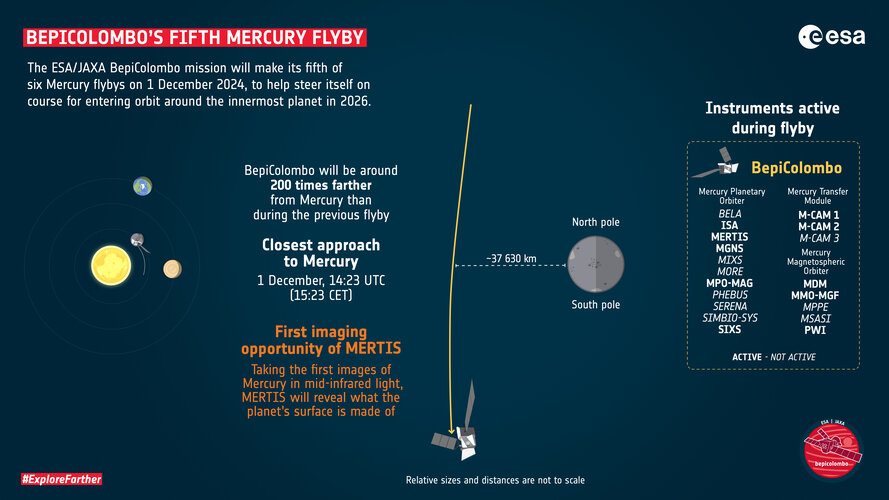On Sunday 1 December 2024, BepiColombo will fly past planet Mercury for the fifth time, readying itself for entering orbit around the Solar System’s mysterious innermost planet in 2026.
The spacecraft will fly between Mercury and the Sun, getting to within 37 630 km from the small planet’s surface at 15:23 CET. This is much farther than its first four flybys of the planet, when BepiColombo flew as close as 165–240 km from the surface.
What makes this flyby special is that it will be the first time that BepiColombo’s MERTIS instrument is able to observe Mercury. This radiometer and thermal infrared spectrometer will measure how much the planet radiates in infrared light, something which depends on both the temperature and composition of the surface.
This will be the first time that any spacecraft measures what Mercury looks like in mid-infrared wavelengths of light (7–14 micrometres). The data that MERTIS will collect throughout the mission will reveal what types of minerals the planet’s surface is made of, one of the key Mercury mysteries that BepiColombo is designed to tackle.
BepiColombo’s other science instruments will monitor the environment outside Mercury's magnetic field. Among other things, they will measure the continuous (but changeable) stream of particles coming from the Sun known as the solar wind.
The other instruments switched on during this flyby are the magnetometers MPO-MAG and MMO-MGF, the MGNS gamma-ray and neutron spectrometer, the SIXS X-ray and particle spectrometer, the MDM dust monitor and the PWI instrument which detects electric fields, plasma waves and radio waves.
BepiColombo, a joint mission between ESA and the Japan Aerospace Exploration Agency (JAXA), will be the second and most complex mission ever to orbit Mercury. It comprises two science orbiters: ESA’s Mercury Planetary Orbiter and JAXA’s Mercury Magnetospheric Orbiter. While on their way to Mercury, the two orbiters are both attached to the Mercury Transfer Module.
[Image description: Infographic explaining BepiColombo’s fifth flyby of Mercury. In the centre of the graphic we see the spacecraft flying past the planet. On the left we see the inner Solar System in perspective, with the positions of Mercury, Venus and Earth indicated. On the right we see which of BepiColombo’s instruments will be activated during the flyby.]



 Image:
BepiColombo's fifth Mercury flyby
Image:
BepiColombo's fifth Mercury flyby